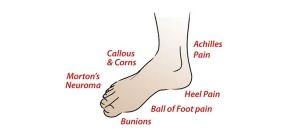High arch foot
Most people have an arch along the inner side of the foot, leaving a gap between the ground and the foot. Some feet have a higher arch than average. This is the opposite of a flatfoot. In combination with a higher arch, the ankle may be "rolled" outwards slightly - this is the opposite of a pronated foot. Often this gets referred to as pes cavus.
What does a high arch foot look like?
When standing with weight on the foot, the arch will appear higher. The heel often tilted inwards at the ankle (but not always). In many the toes will appeared clawed. When not standing the front half of the foot (forefoot) will appear to be dropped below the level of the rearfoot.
What causes high arch feet?
High arch feet may just be a normal variant (ie some people just have higher arches), some may be hereditary (ie runs in the family) and in some cases there may be an underlying neurological problem that is causing it.
What are the symptoms of a high arch foot?
The symptoms of a high arch foot will vary depending on how severe the condition is and the activity levels of the person with it. Most will have no pain or any other symptoms. Symptoms may vary from a mild problem with shoe fitting to significant disability.
Some of the symptoms can include:
- there may be corns and calluses under the bases of the first and fifth toes.
- Shoe may not fit very well because of the high arch and the clawed toes.
- There may be some pain in the arch area, because of the pressure that it is under.
- The feet will feel stiffer and less mobile than a foot that does not have a high arch.
- An ankle sprain are more common in those with a high arched foot.
How is the high arched foot treated?
This will depend on what is causing the pain, if anything. Initially a careful investigation is needed to rule out any neurological condition is causing the high arched foot.
Generally, treatment can involve:
-
The use of foot orthotics or insoles to support and protect the foot and relieve pressure areas.
-
Different sorts of pads made from silicone or felt can be used to get pressure off the painful areas
- If corns and callus are present, they can be treated by a Podiatrist.
- Proper fitting of footwear is important.
- In very sever cases, especially if pain is present and the height of the arch is progressively increasing in height, surgery may be considered.
8 Common Foot Problems
Fungal and Bacterial Conditions, including athlete's foot, occur because our feet spend a lot of time in shoes - a warm, dark, humid place that is perfect for fungus to grow. Fungal and bacterial conditions can cause dry skin, redness, blisters, itching, and peeling.
Dubai Podiatry Centre Launches Schools Foot Health Drive for Children
Dubai Podiatry Centre has launched its annual Foot Health Campaign for Children in its local Emirate of Dubai, by running a free foot health check-up for children’s feet and legs during October and November 2013.
With the intelligent insole your toe bone really is connected to your foot bone
The old American spiritual had it right, the toe bone is connected to the foot bone, the foot bone's connected to the heel bone, the heel bone's connected to the anklebone and so on through the length of the human body. But these days it's not Ezekiel who's joining up dem dry bones but the Internet of Things (IoT) and a UK-headquartered company HCi Viocare Technologies, the inventor of the Smart Insole.


